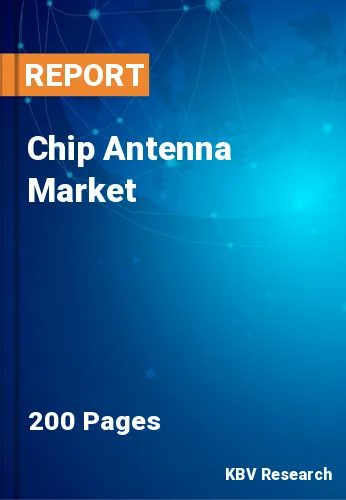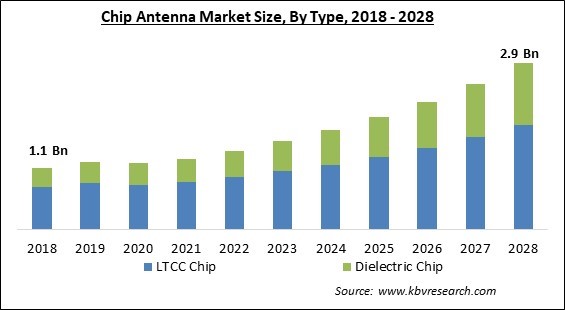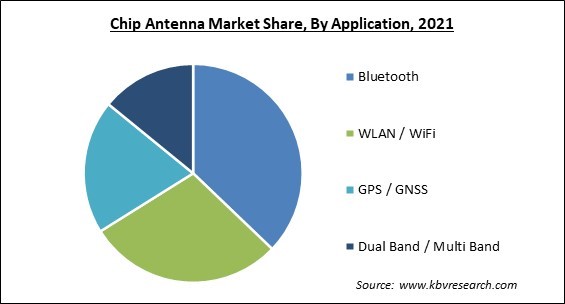
The Global Chip Antenna Market size is expected to reach $2.9 billion by 2028, rising at a market growth of 13.2% CAGR during the forecast period.
Chip antenna is known for its compact footprint, making them a special kind of antenna. They are most frequently integrated onto circuit boards to emit high-frequency electromagnetic waves and are considered ideal for small devices like Wi-Fi routers and cell phones. Chip antennas are smaller than a typical antenna but transmit and receive electromagnetic waves.

This indicates that they are frequently incorporated within compact electronic devices and are reasonably priced, given their high quality. The increasing use of smartphones and tablets, as well as the increasing penetration of the internet, are some of the key factors fueling the market's expansion. Furthermore, the advent of next-generation wireless technologies and the increased demand for reliable connectivity are further aspects that help define the expanding market environment.
In addition, the market for chip antennas is expanding steadily due to rising energy consumption, particularly from the manufacturing industries. Using fractal geometry is one way to design an antenna that may be included on a PCB. A fractal is an intricate pattern created by repeatedly arranging simple shapes in such a way that the material's length or perimeter radiating an electromagnetic signal is maximized.
These antennas must match the signal wavelength, and also the fractal pattern must be preserved in at least two distinct ratios. These antennas, which can be tailored to fit a range of footprints, are showing up more frequently in mobile gadgets. Overall, fractal antennas have remarkable gain and bandwidth. In addition, because fractal antenna designs don't need any extra parts to function, they are more flexible.
The COVID-19 outbreak had a significant negative influence on the chip antenna market. Because of the pandemic, many countries imposed and extended lockdowns, which caused industry and manufacturing facilities all around the world to shut down due to crisis and a lack of labor. As a result, it is determined that the market experienced a decline after considering the opinions of numerous industry experts from different segments of the value chain, including OEMs, integrators, end users, suppliers, and distributors. The financial results of different businesses in the chip antenna ecosystem were also observed to be negative. However, it is anticipated that the market will bounce back in the coming years and continue to rise throughout the projected period.
IoT deployment is likely to increase across all end-user segments, which is anticipated to significantly boost the demand for chip antennae. As IoT equipment automatically analyzes development cycles and maintains warehouses and stocks, they are being used in manufacturing to improve the production flow of a plant. It is one of the main factors behind the recent explosion in IoT device investment. Additionally, the automation industry will incorporate more connectivity with devices by 2025. It will also propel the demand and expansion of the chip antenna market.
Navigational systems provide the ideal routes between two points. It is supported by external technologies like the Global Positioning System (GPS) and satellite-based radio navigation systems. GPS/GNSS has many advantages, including high precision, usability, reliability, and self-calibration. Combining data from many sources is a standard strategy in many fields to improve results. GIS and GPS have been combined to visualize and implement a specific area's characteristics. Thereby fuelling the expansion of the market.
It is anticipated that the demand for chip antenna will decrease by a lack of experienced workers and expensive maintenance and construction costs for the infrastructure needed to enable flat panel antennas. The lack of operability as well as compatibility between supplier and ODM, along with the irregular performance efficiency and insufficient range of chip antenna, are also aiding the problem of using chip antennas. The inconsistency in numerous operating frequencies for various applications serves as the major limitation for the expansion of the chip antenna market during the forecast period. Therefore, all these factors significantly hamper chip antenna utilization and consequently limit the market's growth.
Based on type, the chip antenna market is categorized into LTCC chip and dielectric chip. The LTCC chip segment garnered the highest revenue share in the chip antenna market in 2021. The updated and more affordable variant of HTCC, LTCC (low temperature co-fired ceramic), has firing temperatures between 700 and 960 degrees Celsius. Hybrid circuits, resistors, inductors, transformers, sensors, and microsystems are some of the main uses of LTCC. In a single multilayer package, LTCC provides capabilities like low dielectric loss, high/low permittivity, and multi-functional features through integration and linkages.

On the basis of application, the chip antenna market is divided into WLAN/WiFi, Bluetooth, dual band/multi band, and GPS/GNSS. The GPS/GNSS segment recorded a significant revenue share in the chip antenna market in 2021. The use of chip antenna technology in a range of tracking equipment, fleet management systems, and wearable applications has been shown to provide the optimum GNSS (Global Navigation Satellite System) performance. Different new devices need adaptable GNSS/GPS (Global Positioning System) connections, and chip antennas are the ideal option when size, weight, portability, and cost are concerns.
Based on end user, the chip antenna market is segmented into consumer electronics, automotive, healthcare, telecommunication, and others. The automotive segment garnered a remarkable growth rate in the chip antenna market in 2021. Integrating sensors and security features like ADAS (advanced driver assistance systems) in automotive is the primary factor advancing the segment's expansion. Many onboard sensors, including radars, LiDAR, and cameras, act as the vehicle's eyes to provide perception. ADAS-provided perception works with artificial intelligence to give the vehicle awareness of its surroundings and impediments, both static and moving, anticipated and unanticipated.
| Report Attribute | Details |
|---|---|
| Market size value in 2021 | USD 1.2 Billion |
| Market size forecast in 2028 | USD 2.9 Billion |
| Base Year | 2021 |
| Historical Period | 2018 to 2020 |
| Forecast Period | 2022 to 2028 |
| Revenue Growth Rate | CAGR of 13.2% from 2022 to 2028 |
| Number of Pages | 200 |
| Number of Tables | 369 |
| Report coverage | Market Trends, Revenue Estimation and Forecast, Segmentation Analysis, Regional and Country Breakdown, Companies Strategic Developments, Company Profiling |
| Segments covered | Type, Application, End User, Region |
| Country scope | US, Canada, Mexico, Germany, UK, France, Russia, Spain, Italy, China, Japan, India, South Korea, Singapore, Malaysia, Brazil, Argentina, UAE, Saudi Arabia, South Africa, Nigeria |
| Growth Drivers |
|
| Restraints |
|
On the basis of region, the chip antenna market is analyzed across North America, Europe, Asia Pacific, and LAMEA. The Asia Pacific region procured the highest revenue share in the chip antenna market in 2021. IoT spending is primarily concentrated in the Asia Pacific region, with Singapore and South Korea predicted to be among the prominent markets for chip antenna adoption in IoT. Data from the Organization for Economic Co-operation and Development (OECD) shows that South Korea is the nation with the most Internet-connected devices per habitat.
Free Valuable Insights: Global Chip Antenna Market size to reach USD 2.9 Billion by 2028
The market research report covers the analysis of key stake holders of the market. Key companies profiled in the report include Linx Technologies, Inc. (TE Connectivity Ltd.), Vishay Intertechnology, Inc., Yageo Corporation, Mitsubishi Materials Corporation, Taoglas, Antenova Ltd., Johanson Technology, Inc., Ignion, SL, and Shenzhen Sunlord Electronics Co., Ltd.
By Type
By Application
By End User
By Geography
The global Chip Antenna Market size is expected to reach $2.9 billion by 2028.
Growing utilization of chip antennas in various IOT applications are driving the market in coming years, however, High cost of implementation and easy detuning issues restraints the growth of the market.
Linx Technologies, Inc. (TE Connectivity Ltd.), Vishay Intertechnology, Inc., Yageo Corporation, Mitsubishi Materials Corporation, Taoglas, Antenova Ltd., Johanson Technology, Inc., Ignion, SL, and Shenzhen Sunlord Electronics Co., Ltd.
The expected CAGR of the Chip Antenna Market is 13.2% from 2022 to 2028.
The Bluetooth segment acquired maximum revenue share in the Global Chip Antenna Market by Application in 2021 thereby, achieving a market value of $1.0 billion by 2028.
The Asia Pacific market dominated the Global Chip Antenna Market by Region in 2021, and would continue to be a dominant market till 2028; thereby, achieving a market value of $1.1 billion by 2028.
Our team of dedicated experts can provide you with attractive expansion opportunities for your business.
